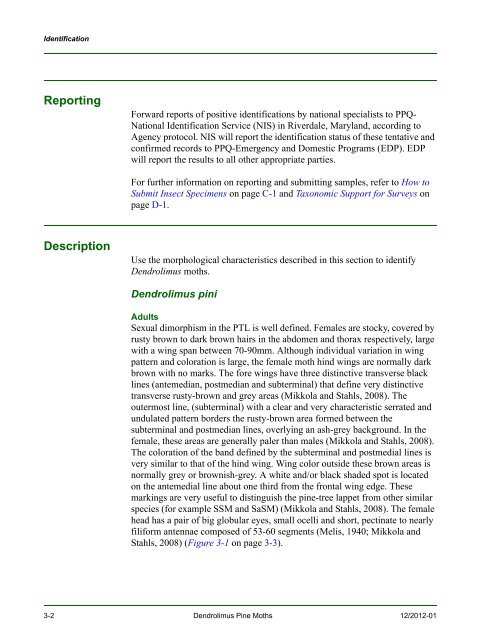New Pest Response Guidelines - aphis - US Department of Agriculture
New Pest Response Guidelines - aphis - US Department of Agriculture
New Pest Response Guidelines - aphis - US Department of Agriculture
Create successful ePaper yourself
Turn your PDF publications into a flip-book with our unique Google optimized e-Paper software.
Identification<br />
Reporting<br />
Description<br />
Forward reports <strong>of</strong> positive identifications by national specialists to PPQ-<br />
National Identification Service (NIS) in Riverdale, Maryland, according to<br />
Agency protocol. NIS will report the identification status <strong>of</strong> these tentative and<br />
confirmed records to PPQ-Emergency and Domestic Programs (EDP). EDP<br />
will report the results to all other appropriate parties.<br />
For further information on reporting and submitting samples, refer to How to<br />
Submit Insect Specimens on page C-1 and Taxonomic Support for Surveys on<br />
page D-1.<br />
Use the morphological characteristics described in this section to identify<br />
Dendrolimus moths.<br />
Dendrolimus pini<br />
Adults<br />
Sexual dimorphism in the PTL is well defined. Females are stocky, covered by<br />
rusty brown to dark brown hairs in the abdomen and thorax respectively, large<br />
with a wing span between 70-90mm. Although individual variation in wing<br />
pattern and coloration is large, the female moth hind wings are normally dark<br />
brown with no marks. The fore wings have three distinctive transverse black<br />
lines (antemedian, postmedian and subterminal) that define very distinctive<br />
transverse rusty-brown and grey areas (Mikkola and Stahls, 2008). The<br />
outermost line, (subterminal) with a clear and very characteristic serrated and<br />
undulated pattern borders the rusty-brown area formed between the<br />
subterminal and postmedian lines, overlying an ash-grey background. In the<br />
female, these areas are generally paler than males (Mikkola and Stahls, 2008).<br />
The coloration <strong>of</strong> the band defined by the subterminal and postmedial lines is<br />
very similar to that <strong>of</strong> the hind wing. Wing color outside these brown areas is<br />
normally grey or brownish-grey. A white and/or black shaded spot is located<br />
on the antemedial line about one third from the frontal wing edge. These<br />
markings are very useful to distinguish the pine-tree lappet from other similar<br />
species (for example SSM and SaSM) (Mikkola and Stahls, 2008). The female<br />
head has a pair <strong>of</strong> big globular eyes, small ocelli and short, pectinate to nearly<br />
filiform antennae composed <strong>of</strong> 53-60 segments (Melis, 1940; Mikkola and<br />
Stahls, 2008) (Figure 3-1 on page 3-3).<br />
3-2 Dendrolimus Pine Moths 12/2012-01

















